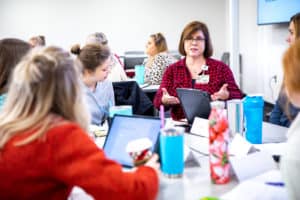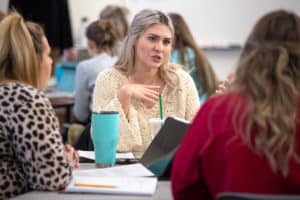View Larger Image

Mark Koch, OTD, (center) speaks with students Awbrey Gibby and Sarah Arenas during a class in January.
Image by the University of Arkansas
Occupational Therapy Program Experiences Eventful First Year
| If you had asked Sherry Muir, Ph.D., OTR/L, earlier this year what challenges she expected when the Doctor of Occupational Therapy program welcomed its first class of students, she wouldn’t have predicted a pandemic disrupting classes just weeks after they started.
However, that is exactly what happened for the collaborative program between the University of Arkansas for Medical Sciences (UAMS) and the University of Arkansas at Fayetteville.

Sherry Muir, Ph.D., (right) instructs students during a class in January. Classes in the Occupational Therapy program started Jan. 2.Courtesy of the University of Arkansas
Muir serves as the chair of the Department of Occupational Therapy (OT) and program director of the program. The 27 students of the first joint education program between the two universities sees students split their time between the UA campus and UAMS Northwest Regional Campus, both in Fayetteville.
Students started their studies Jan. 2, and by mid-March, they transitioned to online courses.
“We didn’t have a tough time with the transition,” Muir said. “Our Blackboard courses were already highly developed and our flipped classroom format, which requires students to grapple with the material ahead of time so that instructors can focus on applying that knowledge, really lent itself to online learning.”
During the spring and summer semesters, students engaged in meaningful, community-based, service-learning partnerships with OT programs across the state and with the local community.
Students interacted with the community through their innovative #yearoftheneighbor2020 project in their wellness course, which took on new meaning when everything went remote. They were challenged to show ways to connect and help people feel “seen” as they got to know their neighbors in new ways, Muir said.
During the summer, students participated in Friendships Bridging Generations, a collaboration with a University of Central Arkansas OT student and residents and staff at Katherine’s Place at Wedington. The goal of this learning experience was to improve social engagement and overall quality of life of nursing facility residents through friendships with college-aged volunteers guided by client-centered, occupation-based activities.
Finally, a community wellness course challenged students to develop holistic wellness proposals for regional community organizations, including the Hope Academy, My-T by Design, Seeds that Feed and UA Student Success. Rogelio Contreras, Ph.D., from UA’s Sam M. Walton College of Business collaborated with OT faculty to bring in a social innovation perspective.
“Our students have done an amazing job of dealing with the unexpected,” Muir said. “Throughout the changes this year, they have really risen to the challenge. I think it really gives us a glimpse of the fantastic therapists they’re going to be.”

Ashlyn Elliott (center) talks with her classmates during an occupational therapy class in January.Courtesy of the University of Arkansas
Muir said her goal is to develop occupational therapists who are capable of treating patients of any age and in any situation.
“We want to produce students who think and act as authentic occupational therapists,” she said. “Therapists need to be able to design innovative interventions for people of all ages who may have physical, cognitive, mental or neurological challenges – and that is what we’re teaching our students.”
Muir and her team were very deliberate when designing the OT spaces on both campuses.
At UA, a two-story OT House serves as a learning and teaching space for instructors and students. The upper level looks like a typical house with two bedrooms – a child’s room with a crib, baby-changing table and bunk beds, and an adult bedroom. A small kitchen features a sink, refrigerator, stove and a number of small appliances. There is also a laundry area, an office and an open dining room and living room.
The house was designed to help students understand the occupational challenges people face when returning to their homes after illness or injury.
“It is imperative that our students understand real life is messy,” she said. “Homes have trip hazards that don’t exist in the clinic and rooms that are too small for adaptive equipment, but a therapist has to be able to teach our patients how to cope with those messy realities.
“Our OT House sits at the top of a hill with a cracked driveway and sidewalk, narrow hallways and a step-in tub. As a therapist, how do I help a patient with a walker navigate those obstacles?”
The downstairs serves as an administrative area, with a meeting room and offices for faculty members, all of whom are occupational therapists with additional advanced degrees. Faculty include Muir; Kandy Salter, OTD, OTR/L, capstone coordinator; Maria Ball, OTD, OTR/L, academic fieldwork coordinator; Jeanne Eichler, EdD, OTR/L, assistant professor; and Mark Koch, OTD, OTR/L, and Anna Harris, OTD, OTR/L, both assistant teaching professors. The program plans to hire one more faculty member to begin July 1, 2021.
On the UAMS campus, the learning lab space includes two apartments that provide unique opportunities not found at the OT House, including a fully handicapped-accessible bathroom with a shower that simulates a hospital setting and a hospice room. This will help students learn how to work with patients who may be in a nursing home or medical facility.
A classroom space called the Lifespan Center includes swings, balance boards and other equipment to address sensory needs and balance. An assistive technology lab will include a 3-D printer for creating prototypes of adaptive equipment and devices to increase independence. A fabrication lab enables students to make orthotics (splints) and casts.
Finally, there is a garage area, where students learn how to help patients navigate the challenges of getting in and out of a car. Patients also will be able to learn to work with tools commonly found in a home garage and understand how to create therapeutic interventions for patients who use these tools in their daily lives
“We want to push the boundaries, shake up the way occupational therapy is normally taught,” Muir said. “For too long, occupational therapists have been siloed in our thinking – we treat children or we treat aging adults.”
“What happens to those adults who have so-called pediatric/developmental diagnoses like cerebral palsy or autism? Their challenges don’t stop when they reach 21. Who treats them? Many diagnoses aren’t age related – we need to be able to help our clients throughout their lifespan.”
Developing a highly integrated curriculum that encompasses this whole person mindset is a challenging endeavor especially since none of the faculty were taught this way, Muir said.
“But I believe this type of teaching is what sets our program apart from others,” she said. “It is also what is going to set apart our students from other occupational therapists out there. We’re getting our students ready to change the world.”
Information for this article was contributed by David Wise.